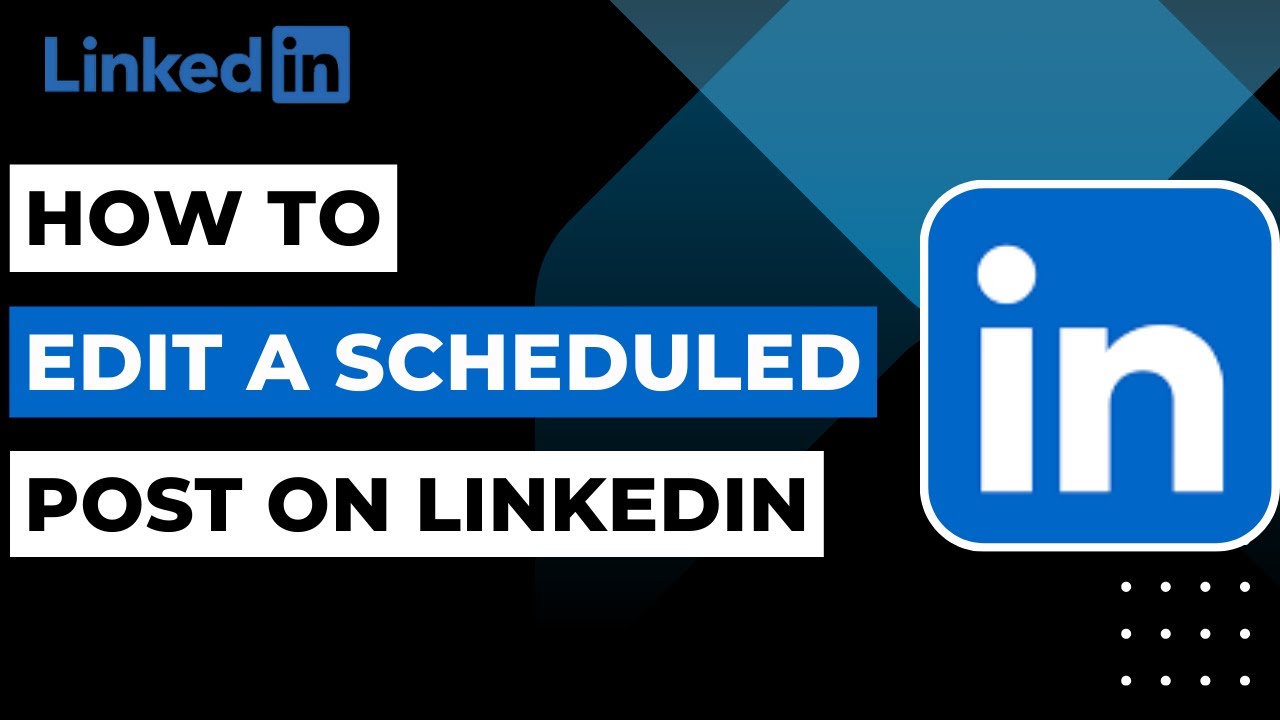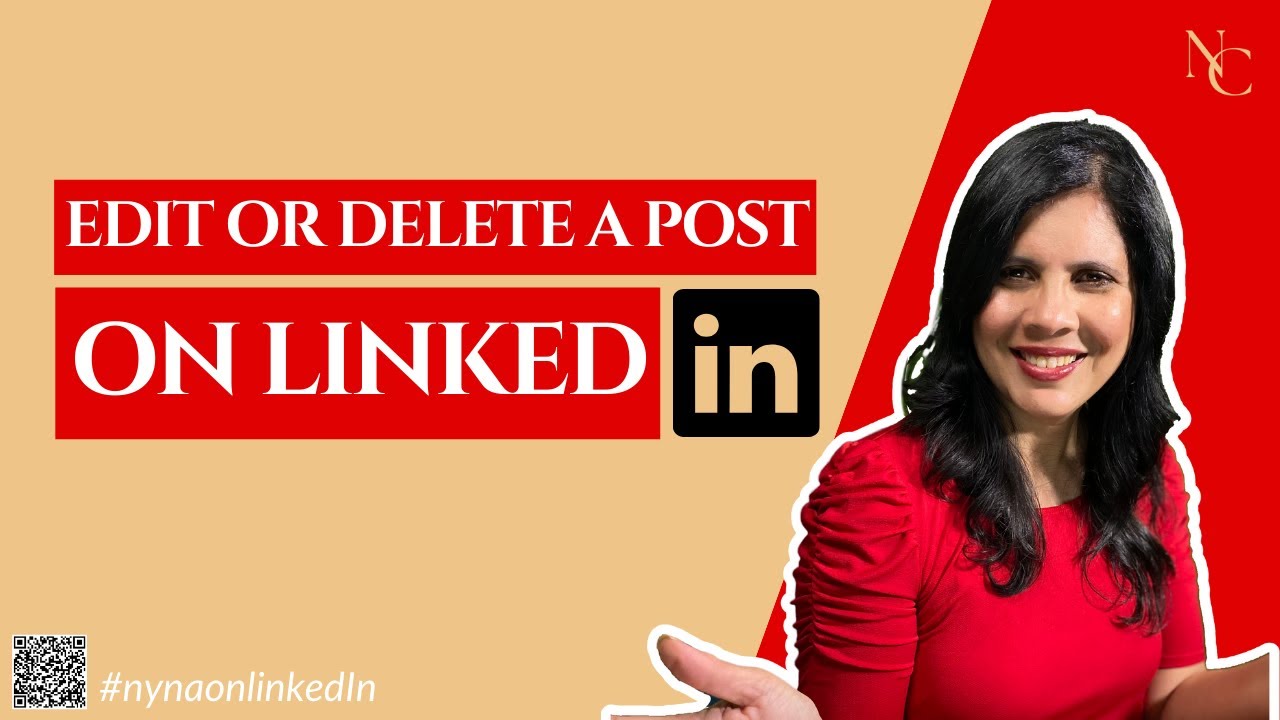Editing a LinkedIn post might seem like a minor task, but it can significantly impact your professional presence online. Whether you’re correcting a typo, refining your message, or enhancing the overall clarity of your post, knowing how to effectively edit can make a difference in how your audience perceives your content. In this post, we'll dive into the nuances of editing LinkedIn posts and explore why you might want to consider making adjustments after hitting that "Publish" button.
Why You Might Want to Edit a LinkedIn Post

There are several valid reasons to edit a LinkedIn post. After all, maintaining a polished and professional presence is essential on this platform. Let’s dive into some of the key reasons you might find yourself wanting to make changes after your post goes live.
- Correcting Typos or Grammatical Errors: It’s easy to overlook minor mistakes in a post, especially when you’re in a hurry to share your thoughts. A typo can undermine your credibility, so a quick edit can help maintain professionalism.
- Updating Information: Sometimes, facts or statistics may change after your post is published. Whether it’s a new development in your field or updated data, keeping your information current ensures your audience trusts your content.
- Enhancing Clarity: While drafting, you might not notice that your message is unclear. Editing allows you to refine your wording, making your ideas clearer and more accessible to your audience.
- Improving Engagement: If your post isn’t generating the engagement you hoped for, consider editing to make it more compelling. This could involve adding a question to prompt discussion or altering the language to better resonate with your audience.
- Changing Context: Sometimes, external factors (like current events) can alter how your post is perceived. Editing allows you to tailor your message to in-the-moment relevance, ensuring it connects with your audience appropriately.
Editing a LinkedIn post isn’t just about correcting mistakes; it’s about refining your professional image and ensuring your messages resonate with your audience. Fine-tuning your content can lead to enhanced networking opportunities, increased visibility, and a stronger online personal brand. So, the next time you post, remember that it’s perfectly acceptable to revisit and improve your content after it’s live!
Also Read This: How Many LinkedIn Connections Can You Send Per Week?
3. Step-by-Step Guide to Editing Your LinkedIn Posts

Editing a LinkedIn post isn't just about fixing typos; it's an opportunity to enhance your content and ensure it resonates with your audience. Here’s a simple step-by-step guide to help you refine your posts like a pro.
Step 1: Access Your Post
First, navigate to your LinkedIn profile or feed. Find the post you want to edit. Click on the three dots (...) at the top right corner of your post. Select "Edit post" from the dropdown menu.
Step 2: Review Your Content
Before making changes, take a moment to read through your post. Consider the overall message and tone. Ask yourself questions like:
- Is the message clear and concise?
- Does it align with my personal brand?
- Is the tone appropriate for my audience?
Step 3: Make Necessary Edits
Now, it’s time to get into the nitty-gritty! You might want to:
- Correct any spelling or grammatical errors.
- Add more context or links to resources.
- Shorten overly long sentences or paragraphs for better readability.
- Incorporate relevant hashtags to increase visibility.
Step 4: Use Formatting Wisely
Formatting can make your post more engaging. Consider using:
- Bulleted or numbered lists to break up information.
- Bold text to highlight key points.
- Line breaks to improve flow and readability.
Step 5: Save Your Changes
Once you’re satisfied with the changes, click "Save" to update your post. Remember, editing can affect engagement, so pay attention to how your edits might change your audience's perception.
Step 6: Monitor Engagement
After editing, keep an eye on the post's engagement levels. Are people responding positively? Did your changes spark new discussions? Use this feedback for future posts!
Also Read This: How to Turn Off Job Alerts on LinkedIn and Control Your Notifications
4. Common Mistakes to Avoid When Editing Posts
While editing your LinkedIn posts, it's easy to make small errors that can significantly impact the effectiveness of your content. Here are some common pitfalls to watch out for:
1. Over-Editing
It might be tempting to tweak every word, but over-editing can lead to a post that feels unnatural. Stick to the essentials and keep your original voice intact.
2. Ignoring the Audience
Editing for yourself rather than your audience can backfire. Make sure you’re considering what your connections would find valuable or engaging. Tailor your edits to enhance their experience.
3. Neglecting Visuals
It’s easy to focus solely on the text while ignoring any accompanying images or multimedia. Remember that visuals can draw people in, so consider updating them if they no longer match your edited content.
4. Not Updating Links
If your post includes links to articles or resources, make sure they’re still active and relevant after editing. Broken links can damage your credibility and frustrate your audience.
5. Forgetting to Proofread Again
After you’ve made your edits, take the time to proofread one last time. You wouldn’t want a missed typo to slip through post-editing!
By being aware of these common mistakes, you can create polished, engaging posts that resonate with your audience and enhance your presence on LinkedIn! Happy editing!
Also Read This: How to Find an Email Address on LinkedIn: Strategies for Contacting
5. Best Practices for Updating Your LinkedIn Content
When it comes to updating your LinkedIn content, there are several best practices you should consider to ensure your posts remain engaging and relevant. Here are some key strategies to keep in mind:
- Keep It Fresh: Regularly check your posts for any outdated information or trends. Updating your content shows that you are active and engaged in your industry.
- Engage with Comments: When you update a post, don’t forget to revisit the comments. Engage with your audience by replying and acknowledging their thoughts. This boosts interaction and encourages more discussions.
- Use Relevant Tags: When editing, make sure to add relevant hashtags or tags to broaden the reach of your post. This helps in categorizing your content and making it discoverable to the right audience.
- Highlight Key Changes: If your updates include significant changes, consider highlighting them. This can be through bold text or bullet points. It makes it easy for readers to grasp what’s new at a quick glance.
- Visuals Matter: Consider adding new images, infographics, or videos when updating your posts. Visual content is more engaging and can enhance the overall impact of your message.
As you follow these best practices, remember that the goal is to maintain an ongoing conversation with your audience. Frequently updating your content not only helps keep your profile dynamic but also demonstrates your commitment to sharing valuable insights.
Also Read This: How to Include a Link in a LinkedIn Post: Step-by-Step Guide
6. How to Re-engage Your Audience After Edits
Re-engaging your audience after you’ve made edits to your LinkedIn post can be a bit tricky but certainly rewarding. It’s all about sparking interest and drawing attention back to your content. Here are some effective strategies to help you achieve that:
- Announce the Update: A simple way to re-engage is to create a new post that announces you’ve made updates to your previous content. You can share what’s changed and why it’s worth a read. This gives your audience a reason to revisit.
- Ask for Feedback: After updating, ask your audience for their opinions on the changes you’ve made. This encourages them to engage and provides you with valuable insights that can shape your future content.
- Tag Engaged Users: If specific users contributed to the discussion in the original post, consider tagging them in your updated post. This personal touch can prompt them to engage again and involves them in the narrative.
- Share a Compelling Story: Reframe the context of your post by sharing a related story or experience. Storytelling can rekindle interest and encourage your audience to connect with the content on a deeper level.
- Utilize Polls or Questions: To stir up more interaction, consider incorporating a poll or question related to the updated content. This is a fun way to collect opinions and keep the conversation flowing.
By implementing these strategies, you’re not just updating a post; you’re breathing new life into your content and rekindling your audience’s interest. Remember to keep the conversation going and remain responsive to their interactions. This fosters a strong community and positions you as a thought leader in your field.
Conclusion: Keeping Your LinkedIn Profile Fresh
Maintaining an up-to-date and relevant LinkedIn profile is crucial in today’s professional landscape. A stale profile can hinder your networking prospects and reduce visibility to potential employers or collaborators. Here are some effective strategies to keep your LinkedIn profile fresh:
- Regularly Update Your Experience: As you gain new skills or change roles, make sure to add these updates to your profile. This reflects your growth and keeps your connections informed.
- Engage With Content: Regularly share insightful articles or thoughts related to your industry. Engaging with other people’s posts by liking, commenting, or sharing shows you’re active in your field.
- Revise Your Summary: Your summary should tell your professional story. Revisit it periodically to ensure it aligns with your current career aspirations and highlights your key achievements.
- Expand Your Network: Continuously connecting with new professionals can provide fresh perspectives and opportunities. Aim to grow your connections by inviting colleagues, industry peers, and alumni.
Take Advantage of Multimedia: Incorporate visuals, such as videos, presentations, or infographics, into your profile. These elements make your profile stand out and can enhance your storytelling.
In conclusion, a dynamic LinkedIn profile not only showcases your professional journey but also opens doors to new opportunities. By regularly updating various sections, engaging with content, and actively expanding your network, you can ensure that your profile stays relevant and compelling. Keep your profile fresh to attract the attention you deserve in your professional endeavors!
 admin
admin








